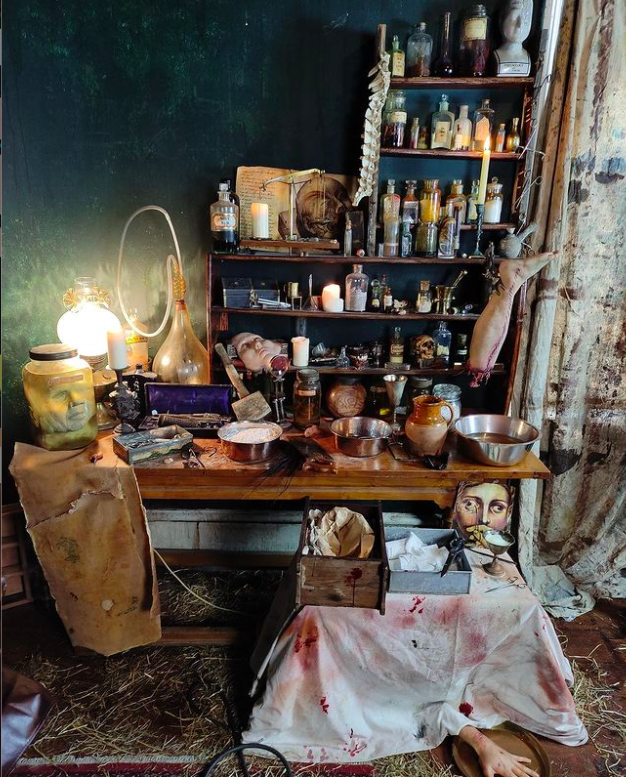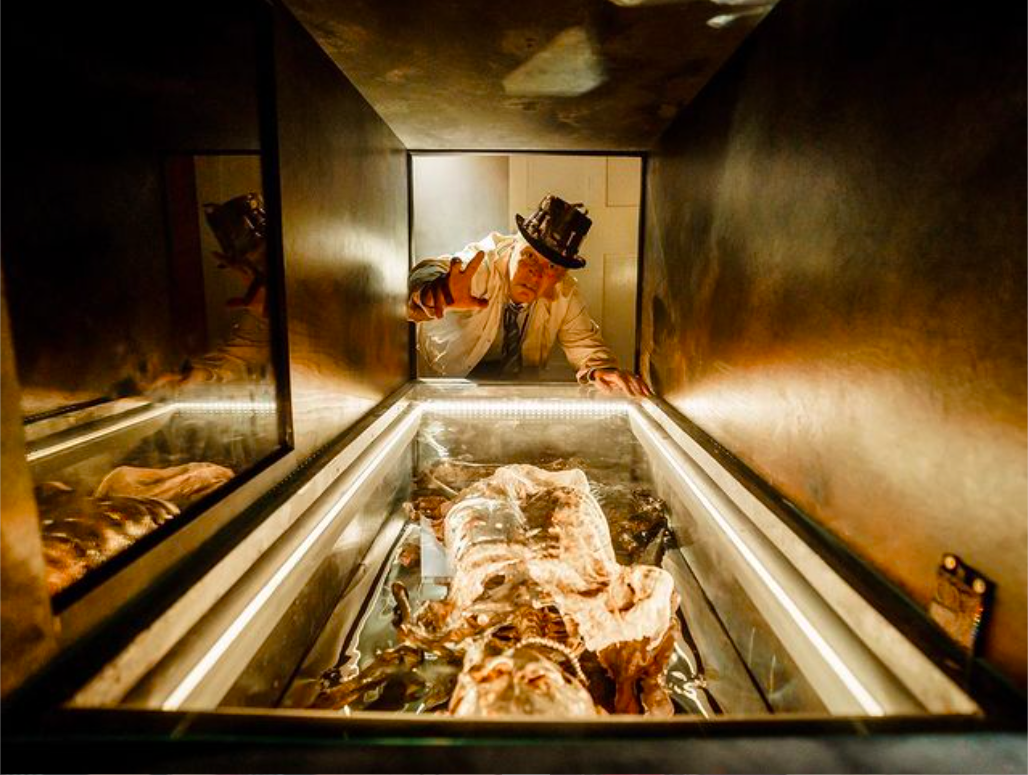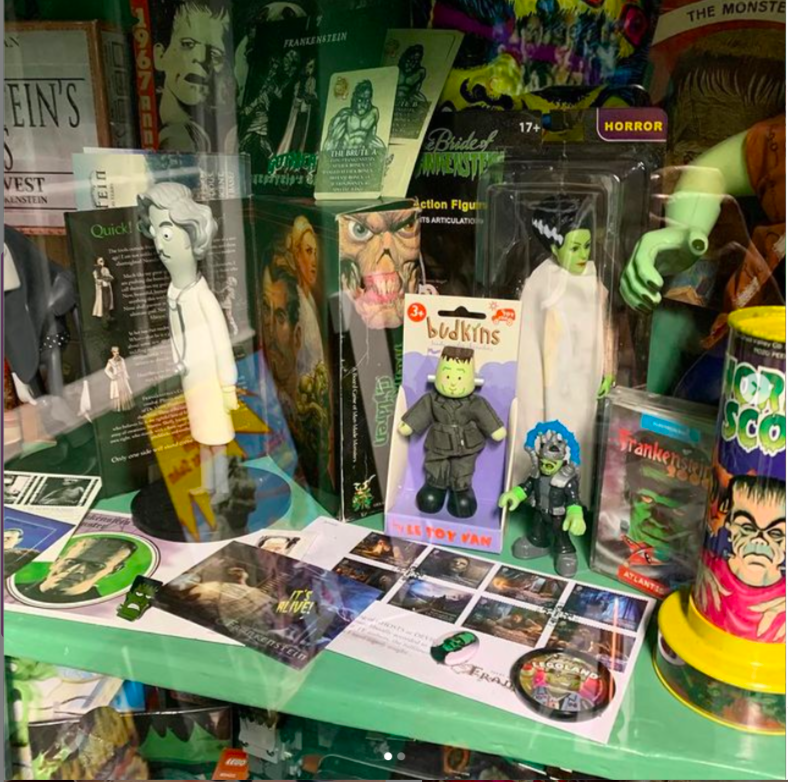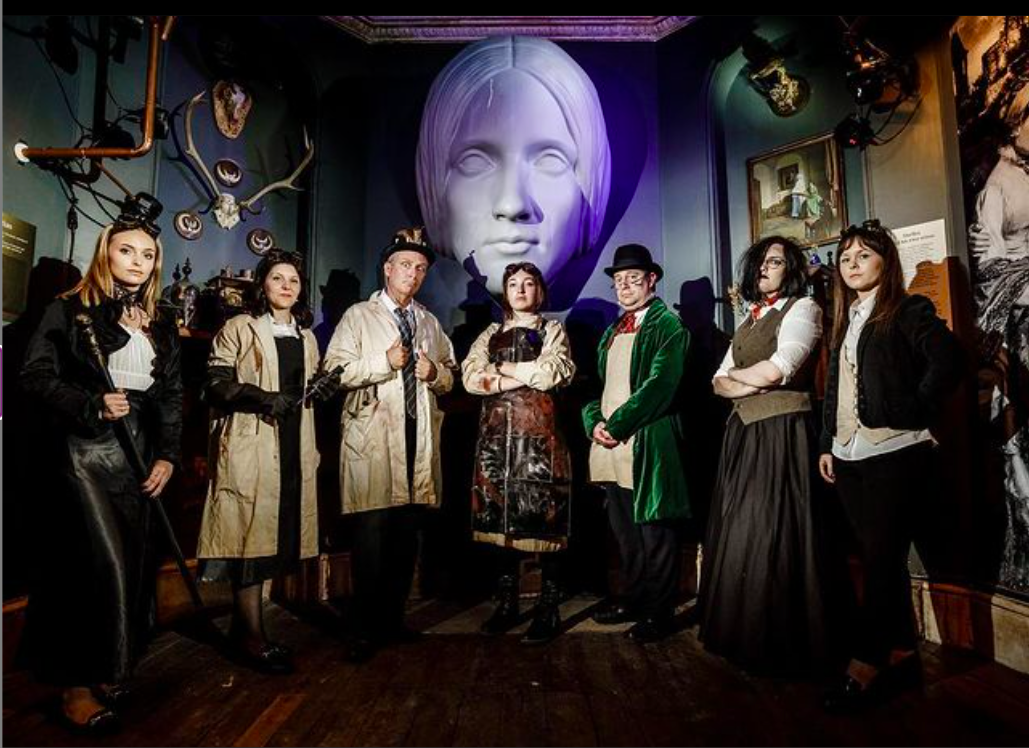[Most Recent Entries] [Calendar View]
Friday, August 6th, 2021
| Time | Event |
| 8:00a | The First Museum Dedicated to Mary Shelley & Her Literary Creation, Frankenstein, Opens in Bath, England Halloween came early this year! Last week, Mary Shelley’s House of Frankenstein opened its doors in Bath, England, mere steps from the infinitely more staid Jane Austen Centre. Both authors had a connection to Bath, a popular tourist destination since 43 CE, as evidenced by the ruins of the Roman thermal spa that give the city its name and UNESCO World Heritage Site status. Austen lived there between 1801 and 1806, and used it as a setting for both Persuasion and Northanger Abbey. The teenaged Shelley’s residence was briefer, but eventful, and creatively fertile. It was here that she wed poet Percy Bysshe Shelley, learned of the suicides of his pregnant first wife and her own half-sister, attended the birth of her illegitimate step-niece (daughter of Lord Byron), attended lectures on galvanism, or reanimation via electrical current… and wrote the majority of Frankenstein. Bath has long mined its connection to Austen, but in embracing Shelley, it stands to diversify the sort of literary pilgrims it appeals to. Visitors to the Jane Austen Centre can try on bonnets, exchange witty repartee with one of her characters, nibble scones with Dorset clotted cream in the tea room, and participate in an annual costume promenade. Meanwhile, over at the House of Frankenstein, expect ominous, unsettling soundscapes, shocking special effects, ghoulish interpreters in blood-spattered aprons, “bespoke scents,” a “dank, foreboding basement experience” and an 8-foot automaton of you-know-who. (No, not Mary Shelley!) Coming soon — Victor Frankenstein’s “miserable attic quarters” repackaged as an escape room “strewn with insane equations, strange artefacts, and miscellaneous body parts.” Co-founder Chris Harris explains the creators’ immersive philosophy:
The BBC reports that the attraction also promises to explore Shelley’s “tragic personal life, literary career and the novel’s continuing relevance today in regards to popular culture, politics, and science.” May not be suitable for children (or timorous Austen fans) as it contains “ominous and foreboding audio and visual effects, darkened environments and some scenes and depictions of a disturbing nature.” Lovers of Pride and Prejudice and Zombies, however, should be sure to exit through the gift shop.
Visit the House of Frankenstein on Instagram where the weekly #FrankensteinFollowerFriday should appeal to monster movie buffs of all ages. Related Content: Ayun Halliday is an author, illustrator, theater maker and Chief Primatologist of the East Village Inky zine. Follow her @AyunHalliday. The First Museum Dedicated to Mary Shelley & Her Literary Creation, Frankenstein, Opens in Bath, England is a post from: Open Culture. Follow us on Facebook and Twitter, or get our Daily Email. And don't miss our big collections of Free Online Courses, Free Online Movies, Free eBooks, Free Audio Books, Free Foreign Language Lessons, and MOOCs. |
| 11:00a | Watch the First Two Hours of MTV’s Inaugural Broadcast (August 1, 1981) Not everyone on August 1, 1981 had a VCR at their disposal, and not everybody stayed up until midnight. But fortunately at least one person did, in order to tape the first two hours of a new cable channel called MTV: Music Television. Did they know it would be historic? MTV certainly hoped it would be: they equated the premiere of this 24/7 video version of radio with the moon landing. People born long after this time might wonder why a MTV Music Video award statuette was honoring Buzz Aldrin. But at the time, it made sense. “Ladies and Gentlemen, Rock and Roll.” It was a statement: less than three decades after the first rock and roll single, this genre of music had won—-it had colonized the planet. And beyond the planet, the next stop: the universe. It’s fitting the execs chose as their first selection The Buggles “Video Killed the Radio Star.” Visuals were not just going to be an adjunct to the music, they were going to become inextricably linked. Either MTV was prescient about the visual decade to come or they in fact caused it to happen. Music videos or short films had been around since the invention of sound in the cinema, but MTV was *all* videos, *all the time*, brought to Americans due to the deregulation of the television industry in 1972 and the slow growth of cable channels. After a Pat Benatar video, the VJs introduce themselves—-Mark Goodman, Nina Blackwood, J.J. Jackson, Alan Hunter, and Martha Quinn (all soon to be household names and crushes)-—and then straight into a block of commercials: school binders, Superman II, and Dolby Noise Reduction. A strange group of advertisers, to be sure. Goodman returns to ask, blindly, “Aren’t those guys the best?” Goodman has no idea what has preceded him. Yes, the first day of MTV was pretty rough. In fact, it’s a bit like a DJ who turns up to a gig to find they’ve left most of their records across town. In the first two hours we get two Rod Stewart songs, two by the Pretenders, two by Split Ends, another Pat Benatar video, two from Styx, and two from the concert film for the People of Kampuchea. We also get completely obscure videos: PH.D. “Little Susie’s on the Up”, Robin Lane and the Chartbusters “When Things Go Wrong”, Michael Johnson “Bluer Than Blue”. This is D-list stuff. No wonder MTV premiered at midnight. From these humble beginning the channel would soon find its groove and two years later it would become ubiquitous in American households. People predicted the end of MTV right from the beginning. It would be a fad, or it would run out of videos to play. Forty years later, the channel has rebranded itself into oblivion. And while music videos still get made-—YouTube’s Vevo megachannel is the current equivalent—-none have the effect that those first two decades had on generations of viewers. To paraphrase the Buggles, we have seen the playback and it seems so long ago. Related Content: Watch David Bowie Take MTV to Task for Failing to Play Music Videos by Black Artists (1983) Ted Mills is a freelance writer on the arts who currently hosts the Notes from the Shed podcast and is the producer of KCRW’s Curious Coast. You can also follow him on Twitter at @tedmills, and/or watch his films here. Watch the First Two Hours of MTV’s Inaugural Broadcast (August 1, 1981) is a post from: Open Culture. Follow us on Facebook and Twitter, or get our Daily Email. And don't miss our big collections of Free Online Courses, Free Online Movies, Free eBooks, Free Audio Books, Free Foreign Language Lessons, and MOOCs. |
| 2:01p | The Only Footage of Bruce Lee Fighting for Real (1967) Two years after the release of Quentin Tarantino’s Once Upon a Time in Hollywood, people are still arguing about its brief portrayal of Bruce Lee. Whether it accurately represented his personality is one debate, but much more important for martial-arts enthusiasts is whether it accurately represented his fighting skills. This could easily be determined by holding the scene in question up against footage of the real Bruce Lee in action, but almost no such footage exists. While Lee’s performances in films like Enter the Dragon and Game of Death continue to win him fans 48 years after his death, their fights — however physically demanding — are, of course, thoroughly choreographed and rehearsed performances. Hence the way, in Once Upon a Time in Hollywood, Brad Pitt’s rough-hewn stuntman Cliff Booth dismisses screen martial artists like Lee as “dancers.” Those are fighting words, and indeed a fight ensues, though one meant to get laughs (and to illuminate the characters’ opposing physical and emotional natures) rather than seriously to recreate a contest between trained martial artist and simple bruiser. As for how Lee handled himself in actual fights, we have no surviving visual evidence but the clips above, shot during a couple of matches in 1967. The event was the Long Beach International Karate Championships, where three years earlier Lee’s demonstration of such improbable physical feats as two-finger push-ups and one-inch punches got him the attention in the U.S. that led to the role of Kato on The Green Hornet. In these 1967 bouts, the now-famous Lee uses the techniques of Jeet Kune Do, his own hybrid martial-arts philosophy emphasizing usefulness in real-life combat. “First he fights Ted Wong, one of his top Jeet Kune Do students,” says Twisted Sifter. “They are allegedly wearing protective gear because they weren’t allowed to fight without them as per California state regulations.” Lee is the one wearing the gear with white straps — as if he weren’t identifiable by sheer speed and control alone. Seen today, his fighting style in this footage reminds many of modern-day mixed martial arts, a sport that might not come into existence had Lee never popularized the practical combination of elements drawn from all fighting styles. Whether the man himself was as arrogant as Tarantino made him out to be, he must have suspected that martial-arts would only be catching up with him half a century later. Related Content: Bruce Lee’s Only Surviving TV Interview, 1971: Lost and Now Found Bruce Lee Auditions for The Green Hornet (1964) The Philosophy of Bruce Lee Gets Explored in a New Podcast The Poetry of Bruce Lee: Discover the Artistic Life of the Martial Arts Icon Watch 10-Year-Old Bruce Lee in His First Starring Role (1950) Based in Seoul, Colin Marshall writes and broadcasts on cities, language, and culture. His projects include the Substack newsletter Books on Cities, the book The Stateless City: a Walk through 21st-Century Los Angeles and the video series The City in Cinema. Follow him on Twitter at @colinmarshall or on Facebook. The Only Footage of Bruce Lee Fighting for Real (1967) is a post from: Open Culture. Follow us on Facebook and Twitter, or get our Daily Email. And don't miss our big collections of Free Online Courses, Free Online Movies, Free eBooks, Free Audio Books, Free Foreign Language Lessons, and MOOCs. |
| << Previous Day |
2021/08/06 [Calendar] |
Next Day >> |






